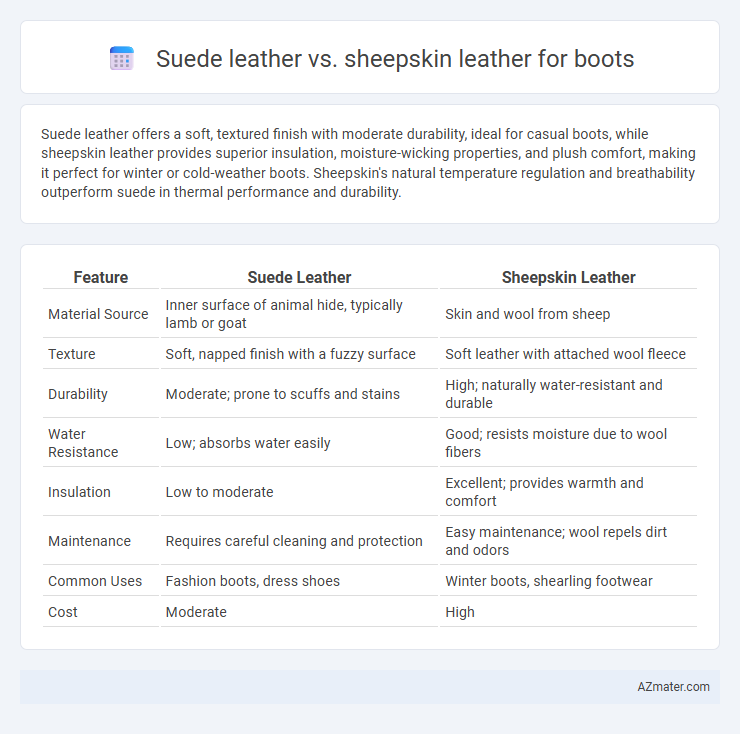Suede leather offers a soft, textured finish with moderate durability, ideal for casual boots, while sheepskin leather provides superior insulation, moisture-wicking properties, and plush comfort, making it perfect for winter or cold-weather boots. Sheepskin's natural temperature regulation and breathability outperform suede in thermal performance and durability.
Table of Comparison
| Feature | Suede Leather | Sheepskin Leather |
|---|---|---|
| Material Source | Inner surface of animal hide, typically lamb or goat | Skin and wool from sheep |
| Texture | Soft, napped finish with a fuzzy surface | Soft leather with attached wool fleece |
| Durability | Moderate; prone to scuffs and stains | High; naturally water-resistant and durable |
| Water Resistance | Low; absorbs water easily | Good; resists moisture due to wool fibers |
| Insulation | Low to moderate | Excellent; provides warmth and comfort |
| Maintenance | Requires careful cleaning and protection | Easy maintenance; wool repels dirt and odors |
| Common Uses | Fashion boots, dress shoes | Winter boots, shearling footwear |
| Cost | Moderate | High |
Introduction to Suede and Sheepskin Leathers
Suede leather is crafted from the underside of animal hides, typically cowhide, featuring a soft, napped finish that enhances flexibility and breathability in boots. Sheepskin leather, derived from the fleece and hide of sheep, offers exceptional warmth and insulation due to its natural wool lining, making it ideal for cold weather footwear. Both materials provide distinctive textures and durability, with suede emphasizing softness and style, while sheepskin focuses on comfort and thermal protection.
What is Suede Leather?
Suede leather is a type of leather made from the underside of animal hide, primarily from calves, lambs, or goats, characterized by its soft, napped finish that provides a smooth and velvety texture ideal for stylish and comfortable boots. Compared to sheepskin leather, which retains the wool on the inner side for added warmth and insulation, suede lacks the natural fleece layer but offers greater flexibility and a more refined appearance. Suede leather requires careful maintenance to prevent water damage and staining, making it a popular choice for fashion-forward footwear rather than heavy-duty outdoor boots.
What is Sheepskin Leather?
Sheepskin leather is made from the hide of sheep, known for its exceptional softness, lightweight feel, and natural breathability, making it ideal for comfortable boots. Unlike suede leather, which is created by sanding the inner split of the hide to produce a napped finish, sheepskin leather retains a smooth surface with a supple texture and offers better insulation properties. Its natural oils provide water resistance and durability, ensuring boots crafted from sheepskin leather remain soft and warm while maintaining long-lasting wearability.
Texture and Appearance Comparison
Suede leather for boots features a soft, napped texture that offers a matte, velvety appearance, creating a casual yet refined look. Sheepskin leather, often with a smooth outer surface and a plush wool-lined interior, provides a luxurious contrast of sleek exterior and cozy softness, enhancing both comfort and style. The visual appeal of suede is characterized by its uniform fuzziness, while sheepskin showcases natural grain patterns and a plush, warm lining that elevates boot aesthetics.
Durability: Suede vs Sheepskin
Suede leather, made from the underside of the animal hide, generally offers moderate durability with a soft texture prone to scuffs and stains. Sheepskin leather, known for its natural oils and dense fibers, provides greater resistance to wear and moisture, enhancing its longevity in boots. For heavy use and outdoor conditions, sheepskin boots tend to outperform suede in durability and maintenance.
Comfort and Insulation Properties
Suede leather offers a soft, flexible texture that enhances comfort through breathability and lightweight feel, making it ideal for moderate climates. Sheepskin leather provides superior insulation due to its dense wool lining, trapping heat effectively and offering excellent warmth in cold conditions. Both materials deliver comfort, but sheepskin excels in thermal retention while suede emphasizes flexibility and moisture evaporation.
Water Resistance and Weather Suitability
Suede leather, with its napped finish, is less water-resistant and requires waterproofing treatments to withstand wet conditions, making it less suitable for rainy or snowy weather compared to sheepskin leather. Sheepskin leather, often treated and naturally dense, offers better water resistance and insulation, making it more appropriate for cold, wet climates while providing warmth and comfort. For boots intended for regular exposure to moisture, sheepskin leather ensures durability and weather protection, whereas suede demands more care and preventive measures.
Maintenance and Care Requirements
Suede leather requires regular brushing with a soft suede brush to remove dirt and maintain its nap, along with the use of water and stain repellents for protection against moisture and stains. Sheepskin leather demands more frequent conditioning with specialized leather conditioners to prevent drying and cracking while also needing gentle cleaning methods to preserve its natural oils and softness. Both materials benefit from avoiding excessive water exposure and storing boots in a cool, dry place to prolong their lifespan and maintain appearance.
Cost Comparison: Suede vs Sheepskin Boots
Suede leather boots generally cost less than sheepskin boots due to differences in processing and material durability, with suede offering a more affordable option for stylish footwear. Sheepskin boots typically command higher prices because of their natural insulation, softness, and premium quality, which enhance comfort and longevity. Consumers seeking budget-friendly boots often prefer suede, while those investing in warmth and luxury favor sheepskin despite the elevated cost.
Best Uses: Choosing the Right Leather for Boots
Suede leather, with its soft texture and breathable quality, is ideal for casual or fashion boots suited for mild, dry conditions, offering comfort and a stylish matte finish. Sheepskin leather, known for its exceptional warmth and moisture-wicking properties, excels in cold and wet environments, making it perfect for winter boots and outdoor activities requiring insulation and durability. Selecting the right leather depends on the intended use: suede for lightweight, fashionable wear, and sheepskin for protective, warm, and rugged footwear.

Infographic: Suede leather vs Sheepskin leather for Boot
 azmater.com
azmater.com